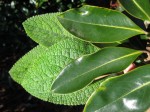
Here are some of the common terms with a few interesting ones thrown in. Having hair or not having hair is a biggy so I divided the terms into these two groups.
1. Without hairs:
-
Glabrous: smooth, not hairy
Coriaceous: leather-like
Rugose: deeply creased with distinct veins
Farinose: mealy, with a covering of waxy, whitish powder
Glaucous: having a whitish or bluish waxy covering
Glutinous: sticky
Scabrose: rough like sandpaper
2. With hairs:
-
Pubescent: having hairs
Arachnoid: having fine, entangled hairs like a cobweb
Downy: having very short, weak, and soft hairs
Tomentose: having matted, wooly hairs
Hirsute: having coarse, stiff hairs
Hispid: rough with bristles, stiff hairs, or minute prickles
Floccose: having flocks of soft, wooly hairs that tend to rub off
Stellate: having star-shaped hairs
Notice how many different kinds of hairiness there are; and this is only part of the list. Some terms overlap each other and more than one term can be used to describe a particular leaf. Some of the differences in hairiness can easily be seen with the naked eye but others are more appreciated with a hand lens, microscope, or electron microscope.
Touching the leaves is a great way to appreciate the various textures and their differences. This characteristic of leaves is especially important to the visually challenged but everyone can benefit from learning to appreciate foliage with more than the sense of sight. I stroke my plants whenever I visit my garden; yes, and sometimes I get pieced by a thorn or stung by a bumble bee. But it’s worth it.

[…] Botany for Gardeners: The Leaf-Texture […]